Stoveless Backpacking Meals – 20+ Cold Soak Recipes
Trying to reduce the weight of your pack and wondering if you can ditch the cooking equipment? As any seasoned backpacker will tell you, every ounce counts! Although some people love the ritual of cooking a meal at the end of the day, our recipes guarantee you won’t miss out on any comfort when backpacking without a stove. The secret is using the cold soak method to rehydrate dry ingredients. Here’s a list of stoveless backpacking meals that will help you feel as if you’re ‘cooking’ on the trail – without the added weight of extra cooking gear.
DIY Backpacking Meals Using the Cold Soak Method
Cold soaking is the process of rehydrating food using nothing but, you guessed it, cold water. The critical difference is that the rehydration process takes more time without heat. So before you start each day, you’ll learn to mix the dry ingredients for your lunch or dinner with cold water and carry it in a container so that it’s ready to go by mealtime.
An ultralight backpacking pro-tip is to prepare the dry ingredients for each cold soak recipe in individual plastic bags before you start your trip. Because there is no risk of the boiling water warping the lightweight bags, you can cold soak your DIY backpacking meals directly in each pre-measured bag. This saves time on the trail and reduces the weight of extra food packaging.
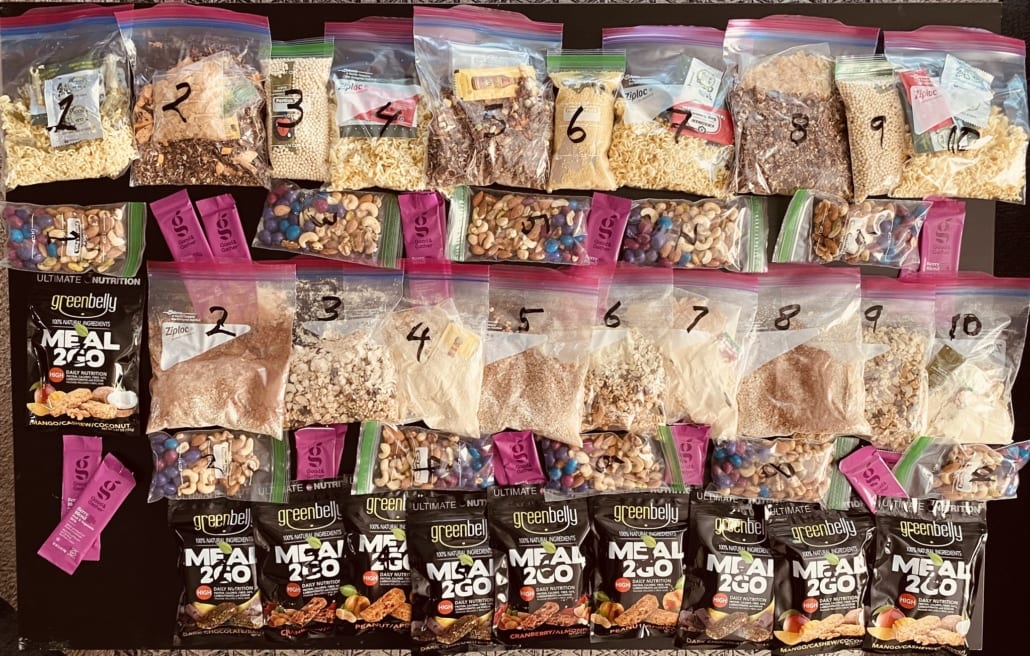
Photo by Dave W. from Facebook
Cold Soak Staple Ingredients
The following ingredients serve as the building blocks of all cold-soak backpacking meals. You can follow our recipes when you’re first getting started, but over time you’ll likely come up with some specialties of your own. You can find most of these ingredients in grocery stores or camping supply shops, but we’ve linked to more specialized ingredients that can be found on Amazon.
- Dehydrated food sampler kit (includes beans, veggies, and meatless options)
- Freeze-dried fruits and veggies kit
- Rolled oats
- Pearl couscous
- Dehydrated beans
- Dehydrated lentils
- Ramen noodles
- Instant mashed potatoes
- Instant rice
- Grits
- Textured vegetable protein (TVP) (a vegan meat substitute)
- Nutritional yeast (a vegan cheese substitute)
- Tortillas
- Powdered hummus
- Powdered milk
- Powdered soy milk
- Coconut milk powder
- Powdered peanut butter
- Powdered butter
- Olive oil packets
Cold Soak Breakfast Recipes
A standard cold soak breakfast starts with oatmeal or muesli. These nutrient-dense staples are a part of every hiker’s menu because they provide sustained energy. And there’s something so comforting about starting your day with a nice bowl of oatmeal porridge! Mix everything the night before so that it’s ready to go by breakfast.
Mix and Match Oatmeal
- ¼ cup rolled oats
- 1 TBS powdered milk
- ⅓ cup dried fruit
- Add cereal or granola after cold soaking
Overnight Oats
- ¼ cup steel oats
- 14 banana chips
- ⅓ cup dried cranberries or raisins
- 3 tsp cacao nibs
- 1 scoop powdered soy milk
Muesli Coconut Power Breakfast
- ¼ cup nut/seed muesli
- ⅓ cup dried fruit
- 1 TBS shredded coconut
- 1 tsp coconut milk powder
- 1 scoop protein powder
Cold Soak Couscous Recipes
Pearl couscous is a staple ingredient for cold soak backpacking meals because it rehydrates easily, even with cold water. The combinations are endless with couscous, so feel free to get creative! It’s a great base for a vegetarian meal, or you can throw in some dehydrated meat. Here are a few cold soak couscous recipes to get you started:
Salmon and Couscous
- 2.5 oz. pearl couscous
- 1 tsp garlic powder
- 1 olive oil packet
- 1 packet mayo
- salmon jerky
Vegan Curry Couscous
- 2.5 oz pearl couscous
- 2.5 oz textured vegetable protein (TVP)
- 1 olive oil packet
- .1 oz curry powder
- .1 oz garlic powder
Instant Potato DIY Backpacking Meals
Some would argue that instant mashed potatoes are almost indistinguishable from the real thing! Mashed potatoes are a traditional comfort food and can be mixed with a variety of ingredients. We found this recipe for Thanksgiving Dinner in a Cup a few years ago, and it’s one of the meals we look forward to on the trail. It’s crave-worthy!
Thanksgiving Dinner in a Cup
- ⅔ cups potato flakes
- ¼ cup Textured vegetable protein (TVP)
- 5 TBS dried cranberries
- 1 TBS nutritional yeast
- 1 TBS turkey gravy mix
- 1 TBS powdered soy milk
- Sea Salt to taste
- Beet chips
Creamy Mashed Potatoes
- Instant mashed potatoes
- Add mayonnaise for max calories and creaminess
- Garlic powder to taste
- S&P to taste
- Optional: shredded Parmesan cheese or nutritional yeast
Ramen Noodle Cold Soak Recipes
Ramen noodles: the staple of college students and seasoned backpackers. The noodles rehydrate easily and make the perfect foundation for a filling meal at the end of a long day. Over the years, the backpacking community has created some delicious cold soak meals which elevate basic ramen noodles to the next level.
Ramen Noodle Pad Thai
- Ramen noodles with seasoning packet
- 1 TBS peanut butter powder
- 1/2 tsp Sriracha
Pesto Noodles
- Ramen noodles without seasoning packet
- .8 oz sun-dried tomatoes
- 1 olive oil packet
- .1 oz garlic powder
- lots of dried basil
- .1 oz Parmesan cheese
Noodles & Peanut Sauce
- Ramen noodles without seasoning packet
- .7 oz crushed peanuts
- Coconut milk powder
- 1 TBS peanut butter powder
- 1 olive oil packet
- .2 oz soy sauce
- .3 oz honey
- .03 oz garlic
Cold Soak Recipes with Dehydrated Beans or Lentils
A great source of protein, dehydrated beans and lentils make an ideal base for stoveless backpacking meals. And you can add lots of spices to beans, which means that your DIY backpacking meals will be anything but bland. Make sure you are buying dehydrated beans or lentils that have been precooked, not just raw dry beans or lentils.
Taco Casserole
- Dehydrated refried beans
- Instant rice
- Taco seasoning
- Tortilla chips
Vegan Curry Lentils
- Dehydrated lentils
- Curry powder
- Coconut milk powder
- Dehydrated veggies
Instant Rice Stoveless Backpacking Meals
Instant rice is another great base for delicious meals without a stove. Again, the possibilities are endless, but here are some classic cold soak recipes from the backpacking community:
Cheesy Broccoli Rice
- Instant rice
- Cheese powder
- Butter powder
- Dehydrated broccoli
Frito Pie
- 2 oz instant refried beans
- 1.5 oz minute rice
- .2 oz taco seasoning
- 1 oz Fritos
- 1 oz extra sharp cheddar
Rice Curry
- Instant rice
- Curry powder
- Coconut milk powder
- Dehydrated veggies
Using Grits for Stoveless Backpacking Meals
Grits belong on any meal plan for backpacking without a stove. They can be used in a breakfast mix or as the foundation in this creamy polenta recipe:
Polenta & Peppers
- 2.5 oz grits
- 0.75 oz dehydrated peppers
- 0.5 oz tomato powder
- 0.1 oz garlic powder
- 1-2 olive oil packets
Tortilla Wraps – Ideal for a Backpacking Lunch
Super versatile, nutrient-dense, and lightweight, a pack of tortillas is a great base for many types of DIY backpacking meals.
Veggie and Hummus Tortilla
- You can use raw veggies and real hummus, or you can cold-soak dehydrated veggies and hummus powder.
Tortilla with sliced meat and cheese
- Feel free to use sliced meat and cheese, or you can cold soak dehydrated meat for an ultralight backpacking meal
Tortilla with peanut butter, banana, dried fruit, cinnamon
- To keep it lightweight, bring dried fruit, banana chips, and powdered peanut butter that you can cold soak during the day.
High-Nutrition Snacks for Stoveless Backpackers
Having lots of options for a snack on the go will keep you satiated so that stopping to eat isn’t a big demand on your time.
- Dried fruit that has been cold soaked – having juicy pineapple on the trail is so refreshing
- Nuts
- Bars
- Dried fruits
- Chips
- Chocolate
- Beef jerky
- Powdered hummus
Pre-Trip Prep: Cold Soak Essential Gear
While backpacking without a stove will reduce the gear that you carry on your back, there is some important gear that will come in handy during the planning phase of your trip.
Sample Pack of Dehydrated Veggies
If you’re interested in making DIY backpacking meals and prefer to experiment with a variety of dehydrated ingredients, a great starting point is to get a sampler kit with various ingredients. You can mix and match ingredients to create your own meals, or just add a scoop of healthy veggies to a pre-made freeze-dried meal. This food sampler from Harmony House includes a variety of beans, dehydrated veggies, and meatless options for vegetarian meals. The pack comes with easy-to-follow recipes and allows you to incorporate a variety of different ingredients in your backpacking menu.
Another option is this freeze-dried fruit and veggie kit that comes with freeze-dried strawberries, bananas, peas, broccoli, and corn. There are 120 servings in the kit, and you just need to add water to rehydrate.
Food Dehydrator
Most of the dry ingredients required for these cold soak meals can be found at camping supply stores. However, specialized dehydrated ingredients can be pricey. Investing in a low-cost dehydrator will help you save money in the long run and will allow you to get creative with your ingredients and DIY backpacking meals. This food dehydrator comes highly recommended by fellow backpackers and can be found on Amazon for around $50. Or if you know you’ll be relying on dehydrated backpacking meals and want to get a more robust machine, this food dehydrator from Cosori comes highly recommended.
Low-Cost Dehydrator – Available on Amazon
Premium Food Dehydrator – Available on Amazon
Digital Scale
Anyone focused on ultralight backpacking is obsessive about the weight of everything in their pack. This also applies to every ingredient in their food supply, which is why recipes for most DIY backpacking meals give measurements in ounces. Instead of doing all the work to convert ounces to standard kitchen measuring volumes, do yourself a favor and invest in a cheap digital kitchen scale. We have this scale which is under $15.
Not ready to give up the heat?
For some, cooking on the trail is part of the joy of backpacking. The recipes above are all possible to make with hot water – if you have a lightweight stove with you, you can just heat the water and mix once you’ve set up camp for the night.
This lightweight backpacking stove is under $20 and is popular among the Ultralight Backpacker community. It’s compact and weighs just .96 ounces (25 grams), but don’t forget to factor in the weight of fuel and a cooking vessel.
Do you have any tried and true backpacking meals? Add them in the comments! And be sure to check out our other blog posts for more gear recommendations.
About the author
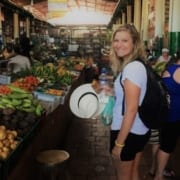
Monica Woerner
Monica is an avid traveler and backpacker who seeks to inspire others to embark on great adventures off the beaten path. Originally from California, she has travelled to over 60 countries, most of which she explored while backpacking or camping.

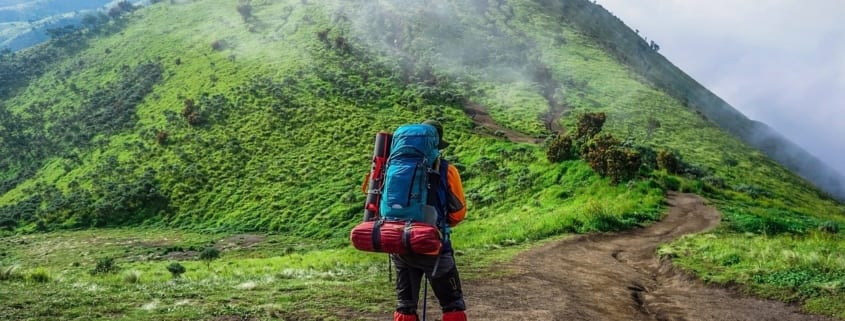






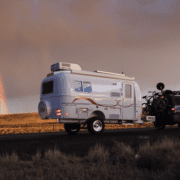
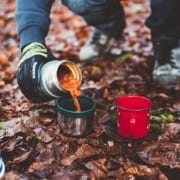
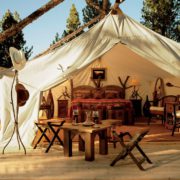

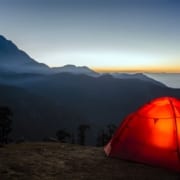

Thank you for this! I think your list of cold soaking options is the most extensive I have found.
An option for a cold soaking container you can also cook with is to use a normal titanium pot and lid set and add a thin piece of silicone sheeting between the pot and lid and hold the lid down with a couple of thick rubber bands or an x-band. Soy curls are a good cold soaking ingredient and the company also makes soy taco crumbles which go well with couscous and black bean flakes and dehydrated salsa.
All the best, Scott
“add a thin piece of silicone sheeting between the pot and lid and hold the lid down with a couple of thick rubber bands or an x-band.” Why?
What silicone and rubber bands do you recommend?
You can also dehydrate most leftover meals and then cold soak them. I do rice and beans and chili with brown rice and I also have a very simple one a friend shared that is 1/3 cup instant rice, a tuna packet, dehydrated peas and a packet of sesame ginger dressing.
We are a bit limited in the UK on some of these ingredients. We don’t have instant rice or dehydrated precooked beans or lentils here, for example, nor do we have tuna or salmon in packets, only in tins, nor olive oil in packets, only in bottles. We don’t even have Talenti gelato to get a free soaking jar! However I’ve tried the Pad Thai recipe and it worked very well. Porridge (oatmeal) worked too, but I found I’d rather just have granola with powdered milk and make it when I get up in the morning.
You may be able to get some of the special ingredients online to really build out your pantry. Another option is to cook ingredients yourself at home and then use a food dehydrator!
Asda have tuna in packets (most stores I’ve checked), and some Morrisons.
Other things will have to home dehydrated, but many air fryers have a dehydrate mode.
Thank you. So how long do the different ingredients need to be soaked?
Hi Alina! Most of the cold soak recipes should be soaked for multiple hours. Without the heat you just have to rely on time. Most backpackers usually mix their cold-soak breakfasts the night before. And lunches or dinners should be mixed with water in the morning so that they can soak throughout the day. Hope this helps!
How much the rehydration process would be speeded up if I was to use hot/boiling water?
Also, I like the idea of soaking breakfast overnight. However, where do I keep it? Not in a tent. If I keep it outside aren’t the critters going to get into it?
Thank you.
To answer the second question first… I would keep it wherever I keep the rest of my food (bag, bear can, ursack). Check at home that your container seals well (fill with water and pour it upside down for a few hours, shake it around, etc.).
As to using hot/ boiling water- at that point it is basically the same as any mountain house/ backpackers pantry meal. Add water, stir, let sit for 10-15 minutes. Be cautious what containers you add very hot water to, and be aware that if it is sealed, the lid could potentially blow off. Whatever method you go with, strongly suggest trying it at home a few times where the penalty for mistakes is just a little wasted food. Don’t want to find out you hate the food on the first night of a week-long trip!
How much water needs to be added to these meals? some of the recipes don’t have amounts of ingredients. Is there a more specific article?
Sound like great recipes…how much water do you add to each recipe?? I imagine it is quite different between, say, rolled oat and steel cut oats.